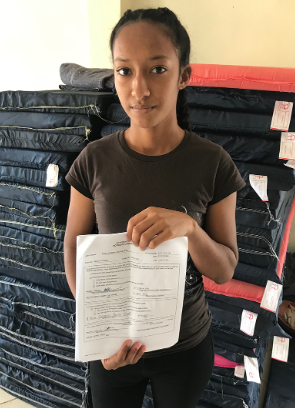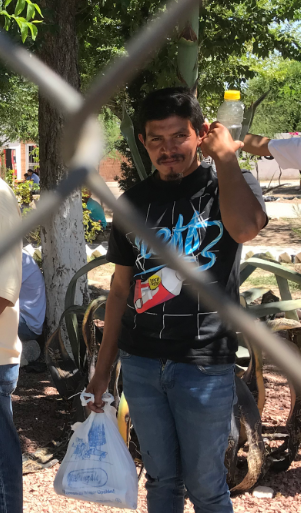We support our Publishers and Content Creators. You can view this story on their website by CLICKING HERE.
In July 2019, I crossed the international bridge from El Paso into the sprawling Mexican border city of Juárez to gauge the effects of President Donald Trump’s so-called “Remain in Mexico” policy.
On that blazing hot summer day, as 20,000 of an eventual 75,000 had just been expelled under the policy, I made my way by taxi to a shelter high up on a rise in the dangerous neighborhood of Anapra. The shelter is within eyesight of Mexico’s side of the American wall and El Paso beyond. I was soon interviewing recent expellee Veronica Janeth Tejeda of Yoro in northwestern Honduras as she played with one of her two expelled children in an outdoor yard between small residential buildings.
Veronica and many other immigrants expelled under Trump’s Remain in Mexico policy back then almost perfectly illustrate the policy’s power to end the greatest border crisis in U.S. history. Their 2019 testimonials matter greatly now that Trump is about to give the controversial policy a comeback that foretells swift operational control of the U.S. southern border.
Recall that before Trump rolled out Remain in Mexico 1.0, the Flores court settlement required (and still does) Border Patrol to quickly release border-crossing families with children inside the United States, where they sink roots during yearslong asylum court backlogs. That prize proved irresistible for hundreds of thousands from across the world.
But introducing Remain in Mexico 1.0 (officially the Migrant Protection Protocols) in 2019 took all wind out of the sails. Border Patrol agents could now quickly expel illegal border crossers back into Mexico and make them wait out the years of U.S. asylum protection claims there. Such a highly deterrent policy made those ineligible for U.S. entry want to stay home instead. No one, after all, illegally crosses for the Great Mexican Dream.
That’s why Remain in Mexico worked so well then and foreshadows a more tranquil border norm very soon again.
Expectations of Easy Law-Breaking Denied
Veronica told me she decided to journey over the American border with her 14-year-old daughter and nine-year-old son because she “heard on the news that mothers and fathers who had kids were crossing into the United States.” Such news of swift release is why migrants come.
“I was told the people from immigration control were going to find us and take care of us, that they were going to take our information and just let me go into the United States,” Veronica said. Veronica was willing, on that good news, to lay down several thousand dollars for smugglers to guide her family through the southern part of Mexico and then over the Rio Grande.
But she slammed into the new American policy. Border Patrol escorted her and her kids back over the bridge to Juarez, with paperwork showing she could come back for an initial immigration court hearing in two months. She knew it would be years before she could get a final judge’s ruling.
Suddenly, American asylum held no interest for Veronica. She wasn’t getting to stay inside the United States to work, the point of the whole effort. Veronica told me she planned to toss the court papers in the trash and return to Honduras with the kids.
“If I knew before that things were going to be like this, I never would have left the country,” she told me.
Veronica Tejeda and her 9-year-old in Juarez holding her Notice to Appear at U.S. immigration court. 2019 photo by Todd Bensman in Juarez.
Very quickly after Remain in Mexico 1.0 was implemented, so many expellees returned to their hometowns that the United Nations International Organization for Migration (IOM) was filling free chartered buses to drive them all the way.
Although impossible to tally, aspiring border-crossers no doubt stayed home in droves during Remain in Mexico’s brief duration. The numbers of border crossings plummeted on news of these stories brought home on the IOM buses and on social media. Veronica said she planned to get on one of the IOM buses home.
Bogus Asylum and Persecution Claims Exposed
Veronica had come to claim asylum from government persecution back home.
“Didn’t you have to flee Honduras with your children or die?” I asked.
Not at all, she answered, a puzzled expression forming on her face. “I just want to go home and find a job in Honduras,” she said.
Decisions from migrants like Veronica show Trump’s Remain in Mexico policy was having its intended psychological impact on decision-making. Their asylum claims weren’t real at all, just a means to achieving indefinite release into America. They did not truly need sanctuary from places that immigration advocates always falsely characterized — and will again in the coming years — as house-on-fire death traps.
Take Gaixania Reyes, a 22-year-old Honduran woman in the same shelter. When I met Reyes, she was upset over her Remain in Mexico deportation two days earlier because her hearing date was five months hence. Gaixania said she reached her decision to head for the Texas border after seeing half her town’s families get in on false asylum claims.
“Thousands left my town. The schools were empty. No kids. No parents. Everybody was saying ‘I can cross with kids,’” she said. “I really thought I would make it in because so many people crossed and got a better life.”
Gaixania was single, without the child golden ticket to get in. But she heard even Hondurans without children were getting pass-through treatment on asylum claims. She ran nose-first into Remain in Mexico instead. Gaixania was still pissed off recalling it.
“I didn’t expect this!” she spat, waving her documents. “I think these papers are a joke! They played with our sentiments and all they did was gave us these papers? When I came here and saw this, I realized they just want to run us off!”

Gaixania Reyes in Juarez circa 2019 holding her “notice to Appear at U.S. immigration court” after her Remain in Mexico expulsion. Photo by Todd Bensman.
Unless this asylum process was going to get her into the United States, Gaixania had no use for it or any asylum. She said she would leave Mexico “as soon as possible.”
“I’ve suffered enough, and I don’t want to suffer more for a waste of time,” she said. The “waste of time” was the prospect of waiting in Mexico instead of working in the United States. Sanctuary from government persecution had nothing to do with her decision.
I asked her: Wasn’t Honduras supposed to be a government killing machine and rape trap, forcing young women like her to flee for their lives and honor? Gaixania said she didn’t see home like that at all. The only other place she wanted to live was the United States because of all the financial opportunities there, she said.
No one I talked to along the migrant trail really cared about “asylum” protection from government persecution back home. They were lying to obtain easy entry into the United States.
At a different migrant shelter across town, Honduran expellee Jose Luis Funes told me he and most of the 700 migrants at the shelter with him were going home instead of waiting out U.S. asylum claims that didn’t get them into America. Their decision was based on the (correct) knowledge that U.S. immigration judges almost never grant Hondurans asylum.
“I’m not going to get asylum,” he said of the long wait ahead of him in Mexico, so “I’m going back.”

Jose Luis Funes of Guatemala just expelled to Juarez under Remain in Mexico in 2019. Photo by Todd Bensman.
Open Borders Activists Hate Remain in Mexico
Open borders activists innately understand the intense deterring power of Remain in Mexico and fight like banshees to kill it. They fired legal headshots and raised a political army of pro-illegal immigration warriors to propagandize against the program and undermine support for it.
Remain in Mexico 1.0 hardly had a chance to take hold after it had expelled some 75,000 immigrants because the first Trump term ended soon after it was implemented. The Biden administration threw out Remain in Mexico on day one. Then we all saw the millions of foreign nationals employing this release-for-years-in-the-U.S. tactic.
The 1.0 policy was in place just long enough to show how well it worked. Now that Trump will resurrect it, a quieter border seems right around the corner for an exhausted America.

 Conservative
Conservative  Search
Search Trending
Trending Current News
Current News 





